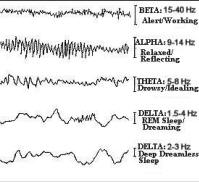Human Brain Parietal eye
brain is an electrochemical organ
Table 02 Human Brain Parietal eye
¤The parietal eye is not an eye in the traditional sense in that it does not see images, but
rather is a photosensitive organ which only reacts to light and dark. The parietal eye is connected to the pineal body and is used to trigger hormone production and thermoregulation. It
often shows up as either a dark spot or an opalescent spot. Opsin proteins sensitive to blue and green light has been identified in the cell.

It is well known that the brain is an electrochemical organ; a fully functioning brain can generate as much as 20 watts of electrical power. Even though this electrical power is very limited, it does occur in very specific ways that are characteristic of the human brain. Electrical activity emanating from the brain can be displayed in the form of brainwaves. There are four categories of these brainwaves, ranging from the most active to the least active. Figure 03e is produced by anEEG (ElectroEncephaloGraph) chart recorder to show the different kind of brainwave according to the different state of the brain. These are all oscillating electrical voltages in the brain, but they are very tiny voltages, just a few millionths of a volt. Electrodes are placed on the outer surface of the head to detect electrical changes in the extracellular fluid of the brain in response to changes in potential | | among large groups of neurons. The resulting signals from the electrodes are amplified and recorded.
|
Brain waves originate from the cerebral cortex, but also reflect activities in other parts of the brain that influence the cortex, such as the reticular formation. Because the intensity of electrical changes is directly related to the degree of neuronal activity, brain waves vary markedly in amplitude and frequency between sleep and wakefulness. Beta wave rhythms appear to be involved in higher mental activity, including perception and consciousness. It seems to be associated with consciousness, e.g., it disappears with general anesthesia. Other waves that can be detected are Alpha, Theta, and Delta. When the hemispheres or regions of the brain are producing a wave synchronously, they are said to be coherent. Alpha waves are generated in the Thalamus (the brain within the brain), while Theta waves occur mainly in the parietal and temporal regions of the cerebrum. The Alpha and Theta waves seem to be associated with creative, insightful thought. When an artist or scientist has the "aha" experience, there's a good chance he or she is in Alpha or Theta. These two kinds of brain waves are also associated with relaxation and, stronger immune systems. Therefore, many people try to train themselves to enter such states through various biofeedback
7 techniques (with varying degree of success). Delta Waves occur during sleep. They originate from the cerebral cortex when it is not being activated by the reticular formation. In slow-wave sleep, the entire brain oscillates in a gentle rhythm quite unlike the fragmented oscillations of normal consciousness. The neocortical activity is often modulated by a rhythm of 40-80 Hz, called the Gamma wave (not shown in Figure 03e). When there are strong gamma oscillations in certain parts of the neocortex, human subjects do better on learning and memory tasks.
continued to spinal cord page
